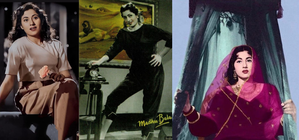New Delhi: Her incandescent beauty, innocent sensuality, and effervescent persona still send hearts aflutter and earned her the sobriquet of “Venus of Indian films”, but Madhubala’s enigmatic and beguiling smile and charm masked a lifetime of pain and suffering.
Madhubala, who passed away on this day (February 23) in 1969, earned tributes that have rarely been matched, leave alone surpassed.
She acted in a film named after her when she was not even midway through her career, was being copied or parodied when she was still acting, and is possibly the only Indian, film or otherwise, with a song dedicated to her being played at the Olympics.
She was also compared to the near-contemporary Marilyn Monroe – the two would pass away within a few years of each other, both aged 36, but did not welcome this as she did not consider herself a sex symbol.
Performances as the captivating but star-crossed Anarkali of “Mughal-e-Azam” (1960), the otherworldly spectre in “Mahal” (1949) or the nightclub singer in “Howrah Bridge” made her memory indelible, but Madhubala’s ouevre was much more genre-spanning.
She could display her exuberant, effusive and elfin charm in romantic comedies such as “Chalti Ka Naam Gaadi” (1958), “Jhumroo” (1961) and “Half Ticket” (1962), and also stood out in ghost/gothic stories, comic crime capers, and film noir, beyond the usual Hindi film staple of romantic dramas.
Her fame, though, came at a personal cost.
Born fittingly on Valentine’s Day (February 14), 1933, in Delhi in a Pashtun family as Mumtaz Jahan Begum, she was only seven when she was saddled with the responsibility of earning for the family as her father lost his job. She began singing on AIR for music virtuoso Khwaja Khurshid Anwar and began her film foray from 1941 when the family moved to Bombay to better cash in on her talents.
This family control, especially by her father, in both her personal and professional spheres, not only robbed Madhubala of her childhood, but would also hang heavy on her subsequent — and short — life and relationships.
And then there was a congenital heart defect, which made her frequently cough up blood and left her breathless and weak. At that time, there was no surgical cure and her condition only got worse and incapacitated her during her last few years.
Debuting with an uncredited role in “Bahar” (1942), Madhubala did half-a-dozen-odd films as a child artiste before her first adult role in “Neel Kamal” (1947) – the first starring role for Raj Kapoor – made her stand out.
It was after this that Devika Rani – who was responsible for naming Ashok Kumar (Kumudlal Ganguly) and Dilip Kumar (Muhammed Yusuf Khan) – suggested that she take on the screen name Madhubala.
She starred in another seven or eight films – most of them now lost – in 1947 and 1948, before hitting the big time with “Mahal” (1949), where her out-of-world signature song “Aayega aanewala” also introduced India to the voice of Lata Mangeshkar.
In 1950, she appeared in films with all the top heroes – opposite Ashok Kumar in “Nishana”, Dev Anand in “Nirala” and “Madhubala”, Motilal in “Hanste Aansoo” (the first film to get an ‘A’ certificate), Ajit, who was till then still appearing in hero roles, in “Beqasoor”, and Rehman in “Pardes”.
“Tarana” (1951), which is still remembered for the soulful duet “Seene mein sulagte hai arman”, was Madhubala’s first opposite Dilip Kumar, and saw kindling of their romance, which lasted till the “Naya Daur” controversy in 1956, where she was sued for walking out of the picture and he testified against her.
They also worked together in “Sangdil” (1952) and “Amar” (1954) before K.Asif’s magnum opus — “Mughal-e-Azam”.
She is also known for the treasure hunt flick “Khazana” (1951), where she became possibly the first Indian heroine to sport trousers onscreen; and the urban romantic drama “Rail Ka Dibba” (1953), where she bowled over her co-star, Shammi Kapoor.
In a 2011 interview, Kapoor swore he had “never seen a more beautiful woman”, who was also blessed with “sharp intellect, maturity, poise and sensitivity”.
Madhubala also showed her prowess in the noirish adventure “Gateway of India” (1957), possibly the first film to show the heroine running after the hero to propose to him! And we got to see a more vulnerable side in the social drama “Barsaat Ki Raat” (1960).
Her 70-odd films gathered her legions of fans in India, as well as Southeast Asia, East Africa, and even Greece – where popular singer Stelios Kazantzidis produced song “Mandoubala” as a tribute to her after her demise. This was played at the closing ceremony of the 2004 Athens Olympics.
On the other hand, her personal life was muddled – after two failed romances (Premnath and Dilip Kumar) and proposals galore from co-stars, she married Kishore Kumar in 1960, but her failing heath precluded a happy marital life before her heart condition claimed her.
–IANS


Comments are closed.